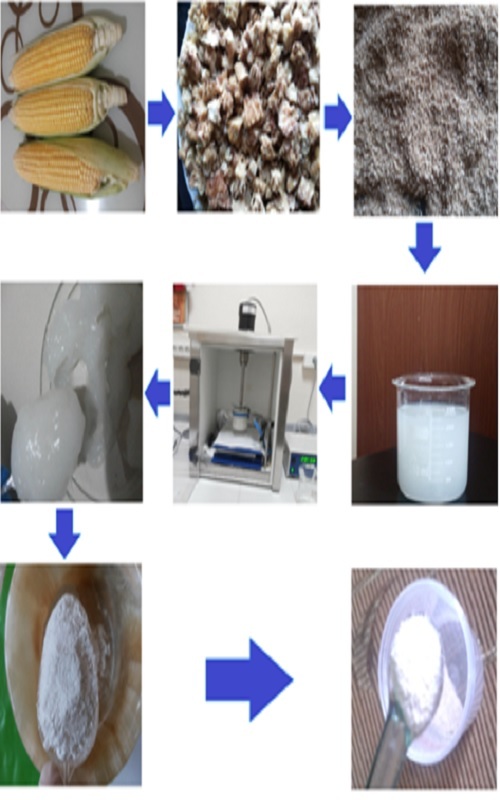Refinement technique for nanocellulose extraction from corn cobs as a green material for environmental sustainability Scientific paper
Main Article Content
Abstract
Corn cob and other types of agricultural biomass waste are abundant and have several potential uses as renewable materials. A unique extraction approach for producing nanocellulose materials with precise control, scalability, and promising practical applications has been presented. Nanocrystalline cellulose was produced from corn cobs by mechanical treatment with ultrasonic technology, room temperature extraction for 30 min, and sulfuric acid concentrations ranging from 30 % to 0% w/v. Nanocellulose has been effectively extracted from maize cobs with comparatively high yields and crystallinities ranging from 63.55% to 71.76%. The TEM data demonstrate the production of fiber nanoparticles with a size range of 15.3 nm to 2.1 nm. Simultaneously, SEM results match TEM findings. SEM pictures indicate smaller nanoparticles as sonication duration rises, but particle size does not vary with acid content. XRD analysis indicates an increase in the amount of crystalline cellulose in nanocellulose, demonstrating a notable transformation of cellulose. Nanocellulose and cellulose had similar FTIR spectra, distinct from the basic material of corn cobs. The FTIR analysis showed that the NaOH and subsequent bleaching treatments eliminated most hemicellulose and nearly all lignin throughout the conversion process. This work introduces a method for extracting nanocellulose from corncob waste utilizing standard ultrasonic technology under moderate conditions, at a cheap cost, in an ecologically responsible manner, with a high yield while maintaining its integrity.
Downloads
Metrics
Article Details

This work is licensed under a Creative Commons Attribution 4.0 International License.

Authors retain copyright and grant the journal right of first publication with the work simultaneously licensed under a Creative Commons Attribution license 4.0 that allows others to share the work with an acknowledgement of the work's authorship and initial publication in this journal.
References
Y. Mahmoud, Z. Safidine, N. Belhanecche-Bensemra, J. Serb. Chem. Soc. 86 (2021) 521 (https://doi.org/10.2298/JSC200806011M)
C. Chang, I. Wang, K. Hung, Y. Perng, J. Taiwan Sci. 25 (2010) 251 (https://doi.org/10.7075/TJFS.201009.0251)
A. Mandal, D. Chakrabarty, Carbohydrate Poly. 86 (2011) 1291 (https://doi.org/10.1016/j.carbpol.2011.06.030)
A. Al-Rawi, I. Al-Khateeb, T. Zaidan, Env. Nanotech. Monit. Manag. 16 (2021) 100529 (https://doi.org/10.1016/j.enmm.2021.100529).
Z. Raji, A. Karim, A. Karam, S. Khalloufi, Waste 1 (2023) 775 (https://doi.org/10.3390/waste1030046)
K. Staszak, K. Wieszczycka, Membranes 13 (2023) 114 (https://doi.org/10.3390/membranes13010114).
A. Etale, A. Onyianta, S. Turner, S. Eichhorn, Chem. Rev. 123 (2023) 2016 (https://doi.org/10.1021/acs.chemrev.2c00477)
R. Castro-Muñoz, L. González-Melgoza, O. García-Depraect, Chemosphere 270 (2021) 129421 (https://doi.org/10.1016/j.chemosphere.2020.129421)
A. Sharma, Anjana; H. Rana, S. Goswami, J. Polymers Environ. 30 (2022) 1 (https://doi.org/10.1007/s10924-021-02185-4)
A. Mautner, Polym. Int. 69 (2020) 741 (https://doi.org/10.1002/pi.5993)
N. Camparotto, G. Paixão, G. de Vargas Brião, R. Oliveira, P. Prediger, M. Vieira, Environ. Toxic. Pharm. 99 (2023) 104105 (https://doi.org/10.1016/j.etap.2023.104105)
T. Sen, Molecules. 21(2023) 5575 (https://doi.org/10.3390/molecules28145575)
M. Vukčević, M. Maletić, B. Pejić, N. Karić, K. Trivunac, A.P. Grujić, J. Serb. Chem. Soc. 88 (2023) 669 (https://doi.org/10.2298/JSC221213015V)
N. Shahi, B. Min, B. Sapkota, V. Rangari. Sustainability 12 (2020) 6015 (https://doi.org/10.3390/su12156015)
M. Klaas, C. Greenhalf, M. Ouadi, H. Jahangiri, A. Hornung, C. Briens, F.Berruti, Results Engineering 7 (2020) 100165 (https://doi.org/10.1016/j.rineng.2020.100165)
J. Kevin, B. Shinners, N. Binversie, Biomass and Bioenergy 31 (2007) 576 (https://doi.org/10.1016/j.biombioe.2007.02.002)
S. Guo, X. Li , Y. Kuang, O. Rojas, Carbohydrate Polymers 253 (2021) 117223 (https://doi.org/10.1016/j.carbpol.2020.117223)
Y. Vishnoi, A. K. Trivedi, M. K. Gupta, H. Singh, S. M. Rangappa, S. Siengchin, Heliyon 10 (2023) e23846 (https://doi.org/10.1016/j.heliyon.2023.e23846)
S. Varshney, V. Mulpuru, N. Mishra, M. K. Gupta, Mater. Technol. 37 (2022) 2608-2622 (https://doi.org/10.1080/10667857.2022.2051939)
I. Al-Khateeb, S. Hussin, Y. Al-Obaidi, Int. J. Mate. Chem. Phys. 1 (2015) 99-109 (http://files.aiscience.org/journal/article/html/70130018.html)
H. A, Silvérioa, W. P. F. Netoa, N. O, Dantas, D. Pasquini, Ind. Crops Prod. 44 (2013) 427–436 (https://doi.org/10.1016/j.indcrop.2012.10.014)
D. Sartika, A. P. Firmansyah, I. Junais, I. W. Arnata, F. Fahma, A. Firmanda, Int. J. Biol. Macromol. 240 (2023) 124327 (https://doi.org/10.1016/j.ijbiomac.2023.124327)
L. Wu, F. Tian, J. Sun, J. Appl. Polymers Sci. 138 (2020) e50206 (https://doi.org/10.1002/app.50206).
K. Seena, P. Thomas, S. Begum, C. Midhun, Dominic, Nisa V. Salim, N. Hameed, Sanjay M. Rangappa, S. Siengchin, J. Parameswaranpillai, J Appl Polymers Sci. 138 (2020) e50213 (https://doi.org/10.1002/app.50213)
H. Kargarzadeh, I. Ahmad, I. Abdullah, Cellulose 19 (2012) 855 (https://doi.org/10.1007/s10570-012-9684-6)
A. Ali, S. Mazumdar, R. Dutta, Cellulose Chem. Technol. 57 (2023) 699 (https://doi.org/10.35812/CelluloseChemTechnol.2023.57.63)
T. Wang, Y. Zhao, Carbohydrate Polymers 253 (2021) 117225 (https://doi.org/10.1016/j.carbpol.2020.117225)
H. Dai, S. Ou, Y. Huang, H. Huang, Cellulose 25 (2018) 1743 (https://doi.org/10.1007/s10570-018-1671-0)
L. Zaini, M. Jonoobi, P. Tahir, S. Karimi, J. Biomaterials and Nanobiotechnology 4 (2013) 37 (http://dx.doi.org/10.4236/jbnb.2013.41006)
A. Görgüç, E. Gençdağ, K. Demirci, B. Bayraktar, A. Zungur-Bastıoğlu, F. Yılmaz, Materials Chemistry and Physics 310 (2023) 128482 (https://doi.org/10.1016/j.matchemphys.2023.128482)
T. Kim, Q. Doan, K. Chiang, Sustainable Environment Research 32 (2022) 26 (https://doi.org/10.1186/s42834-022-00136-9)
Y. Wang, X. Wei, J. Li, Q. Wang, F. Wang, L. Kong, J. Materials Science and Chemical Engineering 1 (2013) 49 (http://dx.doi.org/10.4236/msce.2013.15010).





